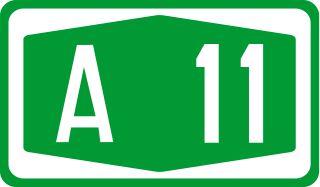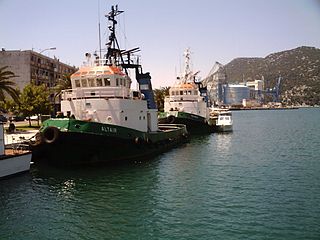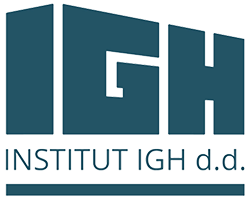
The economy of Croatia is a developing high-income service based economy with the tertiary sector accounting for 60% of total gross domestic product (GDP). After the collapse of Communism, Croatia went through a process of transition to a market-based economy in the 1990s, but its economy suffered badly during the Croatian War of Independence. After the war, the economy began to improve. Before the financial crisis of 2007–08 the Croatian economy grew at 4–5% annually, incomes doubled, and economic and social opportunities dramatically improved.

Baška tablet is one of the first monuments containing an inscription in the Croatian recension of the Church Slavonic language, dating from c. 1100 AD. The inscription is written in the Glagolitic script. It was discovered in 1851 near the village of Baška on the Croatian island of Krk.

The A1 motorway is the longest motorway in Croatia, spanning 476.3 kilometers (296.0 mi). As it connects the nation's capital Zagreb to the second largest city Split, the motorway represents a major north–south transportation corridor in Croatia and a significant part of the Adriatic–Ionian motorway. Apart from Zagreb and Split, the A1 motorway runs near a number of major Croatian cities, provides access to several national parks or nature parks, world heritage sites, and numerous resorts, especially along the Adriatic Coast. National significance of the motorway is reflected through its positive economic impact on the cities and towns it connects as well as its importance to tourism in Croatia.

The A2 motorway is a motorway in the Hrvatsko Zagorje region of northern Croatia, connecting Zagreb to the Macelj border crossing and Slovenia. The A2 motorway is part of the European route E59 and the Pan-European Corridor Xa. The motorway spans 59.2 kilometres (36.8 mi) between the Slovenian border and the Jankomir interchange within the Zagreb bypass, providing road connections to a number of cities and towns besides Zagreb, including Krapina, Zabok and Zaprešić. All sections of the motorway, except the northernmost one between the Macelj border crossing and Trakošćan, and the southernmost one near Zagreb, are tolled, using a closed toll collection system.

The A5 motorway is a motorway in Croatia spanning 55.5 kilometres (34.5 mi). It connects Osijek, the largest city in Slavonia region, to the Croatian motorway network at the Sredanci interchange of the A3 motorway. The A5 represents a significant north–south transportation corridor in Croatia and is a part of the European route E73. The A5 motorway route also follows Pan-European corridor Vc. In addition to Osijek, the A5 motorway also passes near Đakovo.

The A7 motorway is a 42.4-kilometre-long (26.3 mi) motorway in Croatia. It connects the nation's largest port in Rijeka, to the Croatian motorway network, as well as to the Rupa and Pasjak border crossings to Slovenia. The motorway forms part of a longitudinal transportation corridor in Croatia, and it is a part of European route E61 Villach–Ljubljana–Trieste–Rijeka. The A7 motorway route south of Orehovica interchange, where it also intersects Pan-European corridor Vb, is a part of European route E65.

The A9 motorway is a north–south motorway in Croatia, with a length of 78.3 kilometres. Beginning in Pula, the largest city on the Istrian peninsula, it runs north to the Croatian motorway and expressway network at the Kanfanar interchange. Here it meets the A8 motorway, forming the Istrian Y road system. The A9 continues north from here to the Kaštel and Plovanija border crossings into Slovenia. The motorway represents a significant north–south transportation corridor in Croatia and is a part of the European route E751. The motorway's national significance is reflected in the positive economic impact on the cities and towns it connects, as well as its importance to tourism in Croatia. Importance of the motorway for tourism is particularly high during summer tourist seasons, when traffic volume increases by more than 80%.

The A11 motorway is an incomplete motorway in Croatia, 30 kilometres long. It connects the Jakuševec interchange of the Zagreb bypass, to the south of Zagreb, to Velika Gorica and onwards to Sisak, but currently reaches only the Lekenik exit, as of the planned 42-kilometre (26 mi) route, 30 km (19 mi) are completed. The motorway is planned as a north–south transportation corridor for commuter traffic between the cities.
Jadranski naftovod (JANAF) is a crude oil transportation company in Croatia. It operates the JANAF oil transport system, a part of the Adria oil pipeline.
Jamnica is a water bottling company from Croatia and part of Fortenova Group. Its main products are carbonated mineral water Jamnica and still mineral water Jana, named after the two main water springs it uses near Pisarovina on the river Kupa. In addition to water products the company also manufactures juice drinks Juicy, sports drinks Jamnica Pro Sport and soft drinks Sky Cola, TO, and Jana Ice Tea. It is the largest bottled water producer in Croatia.

The Port of Ploče is a seaport in Ploče, Croatia, near the mouth of the Neretva river on the Adriatic Sea coast. It was formally opened in 1945 after a railway was built as a supply route to connect the site with industrial facilities in the Sarajevo and Mostar areas of Bosnia and Herzegovina, which was then part of Yugoslavia. As of 2010, it ranked as the second largest cargo port in Croatia—after the Port of Rijeka—with a cargo throughput of 4.5 million tonnes, consisting mostly of general cargo and bulk cargo, including 20,420 twenty-foot equivalent units (TEUs). In 2008, the Port of Ploče recorded 2,555 ship arrivals. It is managed by the Port of Ploče Authority.

Autocesta Rijeka – Zagreb was a Croatian state-owned joint-stock company founded pursuant to decision of the government of the Republic of Croatia of December 11, 1997, to facilitate construction and subsequent management of a motorway between Rijeka and Zagreb. The company started operating on March 15, 1998. The company issued 21,520 shares, nominally valued at 100,000.00 Croatian kuna each. All company stocks are owned by the Republic of Croatia.

INSTITUT IGH, d.d. is a Croatian company active in civil engineering professional services and scientific research, including development of designs, studies, supervision, consulting, investigation works, assessments, laboratory testing and instrument calibration. The company has received certificates for the services it provides, namely: EN ISO 9001, EN ISO 14001 and OHSAS 18001.
Viadukt is a Croatian civil engineering company, specialised in the areas of bridge, tunnel and road engineering. Other business activities of the company include construction and reconstruction of urban streets.

The Drežnik Viaduct is located in Karlovac, Croatia, immediately to the south of the Karlovac interchange on the A1 motorway. It is the longest viaduct in Croatia, spanning 2,485 metres (8,153 ft). It is executed in seven segments, separated by expansion joints. The viaduct was constructed by Konstruktor, Split, as the main contractor, and Viadukt and Hidroelektra of Zagreb as subcontractors in 2000 and 2001.

The Dobra Bridge is located between Karlovac and Novigrad interchanges of the A1 motorway in Croatia, spanning Dobra River. It is 546 metres (1,791 ft) long, and it comprises four traffic lanes and two emergency lanes.
The Port of Rijeka is a seaport in Rijeka, Croatia, located on the shore of the Kvarner Gulf in the Adriatic Sea. The first records of the port date to 1281. It was the main port of the Kingdom of Hungary in the 19th century and the beginning of the 20th century, of Yugoslavia between World War II and 1991, and of Croatia after its independence. Today, it is the largest port in Croatia with a cargo throughput of 11.2 million tonnes (2016), mostly oil, general cargo and bulk cargo, and 214,348 Twenty-foot equivalent units (TEUs).
Luka Rijeka is a Croatian port operating company which operates port facilities at the largest Croatian Port of Rijeka. In 2010, Luka Rijeka d.d., a concessionaire of the Port of Rijeka reported net profit of 32,000 kuna, a sharp decline from 3.5 million kuna net profit of 2009. Total income in 2010 reached 210.4 million kuna, down from 228.9 million kuna in 2009. In 2010, the company had 935 employees. Share capital of the company is 598 million kuna, and it is listed at the Zagreb Stock Exchange. Since 2002, chairman of the board of the company is Denis Vukorepa. The appointment is limited to a five-year term, and in May 2011, appointment of Denis Vukorepa was extended for the second time. Luka Rijeka d.d. is owned by the state (72.7%), Croatian Healthcare Fund (8.1%) and other stockholders, none of which owns more than 5% of the company stock. Luka Rijeka d.d. concession in the Port of Rijeka is valid until 2012, and a request to renew the concession for another 30 years has been filed.
Dalekovod d.d. is a Croatian company, active in electrical engineering and civil engineering sectors. Its primary activities comprise design, production and construction of electrical power structures, electrical substations, power transmission mains, telecommunications structures, road equipment, railway equipment and street lighting. In 2010, net income of the company was 4.7 million kuna, exhibiting a decrease from 110.9 million kuna net income reported for 2009. At the end of the 2010, the company employed 1424 persons. Dalekovod was founded in 1949 as a state owned company, and restructured as a joint stock company in 1993 and subsequently listed at the Zagreb Stock Exchange. It is one of 24 companies included in the CROBEX share index. As of August 2011, head of the company is Luka Miličić. Recently the company has declared its plans to expand in the energy development sector, especially in the field of renewable energy. In 2012, Dalekovod plans to invest into and build a wind farm near Benkovac and Obrovac.

Grič Tunnel is a pedestrian tunnel located in the city centre of Zagreb, Croatia, under the historic neighbourhood of Grič, which gave the tunnel its name. The tunnel consists of a central hall, which is connected by two passageways to Mesnička Street in the west and Stjepan Radić Street in the east, and four passageways extending to the south. It was built during World War II by the Ustaše government to serve both as a bomb shelter and a promenade, but following the war it quickly fell into disrepair and disuse. The tunnel saw renewed use only in the 1990s, hosting one of the first raves in Croatia, and functioning as a shelter during the Croatian War of Independence. In 2016, the tunnel was remodeled and opened to the public, serving as a tourist attraction and hosting cultural events. Planned expansions include a museum and a lift.













